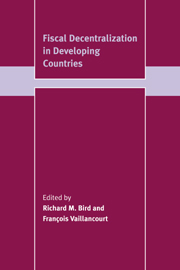Book contents
- Frontmatter
- Contents
- List of tables
- List of contributors
- Preface
- 1 Fiscal decentralization in developing countries: an overview
- 2 China: evaluating the impact of intergovernmental fiscal reform
- 3 India: intergovernmental fiscal relations in a planned economy
- 4 Indonesia and Pakistan: fiscal decentralization – an elusive goal?
- 5 Morocco and Tunisia: financing local governments – the impact on infrastructure finance
- 6 Colombia: the central role of the central government in fiscal decentralization
- 7 Argentina: fiscal federalism and decentralization
- 8 South Africa: an intergovernmental fiscal system in transition
- 9 Bosnia-Herzegovina: fiscal federalism – the Dayton challenge
- Index
5 - Morocco and Tunisia: financing local governments – the impact on infrastructure finance
Published online by Cambridge University Press: 09 October 2009
- Frontmatter
- Contents
- List of tables
- List of contributors
- Preface
- 1 Fiscal decentralization in developing countries: an overview
- 2 China: evaluating the impact of intergovernmental fiscal reform
- 3 India: intergovernmental fiscal relations in a planned economy
- 4 Indonesia and Pakistan: fiscal decentralization – an elusive goal?
- 5 Morocco and Tunisia: financing local governments – the impact on infrastructure finance
- 6 Colombia: the central role of the central government in fiscal decentralization
- 7 Argentina: fiscal federalism and decentralization
- 8 South Africa: an intergovernmental fiscal system in transition
- 9 Bosnia-Herzegovina: fiscal federalism – the Dayton challenge
- Index
Summary
The purpose of this chapter is to present intergovernmental finance arrangements in both Morocco and Tunisia, focusing particularly on the financing of local sector investment. These two countries are of interest in a book of comparative studies since they can be seen as reasonably representative of the French tradition in this field, as perpetuated in Africa. Yet, there are significant differences between them. The chapter has four sections. The first presents the relevant institutional setting; the second describes the main characteristics of intergovernmental finance, which in Morocco requires a presentation of the pre- and post- (1996) reform systems; the third examines the financing of local investment; the final section then evaluates this system in comparison to an ideal system of responsibilities, taxes, transfers, and borrowing mechanisms.
The institutional setting
In this section, the main sociodemographic characteristics of Morocco and Tunisia are introduced. This is followed by a description of the organization of subnational governments in both countries. Finally, there is a commentary on key institutional features.
Sociodemographic characteristics
Table 5.1 summarizes the key sociodemographic characteristics of both countries. Morocco's territory encompasses a coastal plain, mainly on the Atlantic, the Atlas mountain ranges, and a desert region, while Tunisia has a coastal plain and a desertic region. Both countries depend on seasonal rain for their agricultural output and substantial parts of their populations reside on the coast.
I thank participants in the PARADI/ICTS conference and, in particular, Richard Bird and David Sewell for useful comments on a first draft.
- Type
- Chapter
- Information
- Fiscal Decentralization in Developing Countries , pp. 152 - 171Publisher: Cambridge University PressPrint publication year: 1999
- 1
- Cited by



